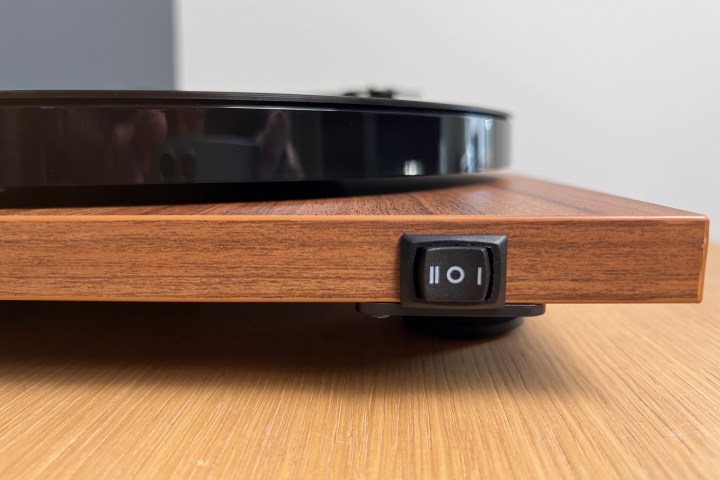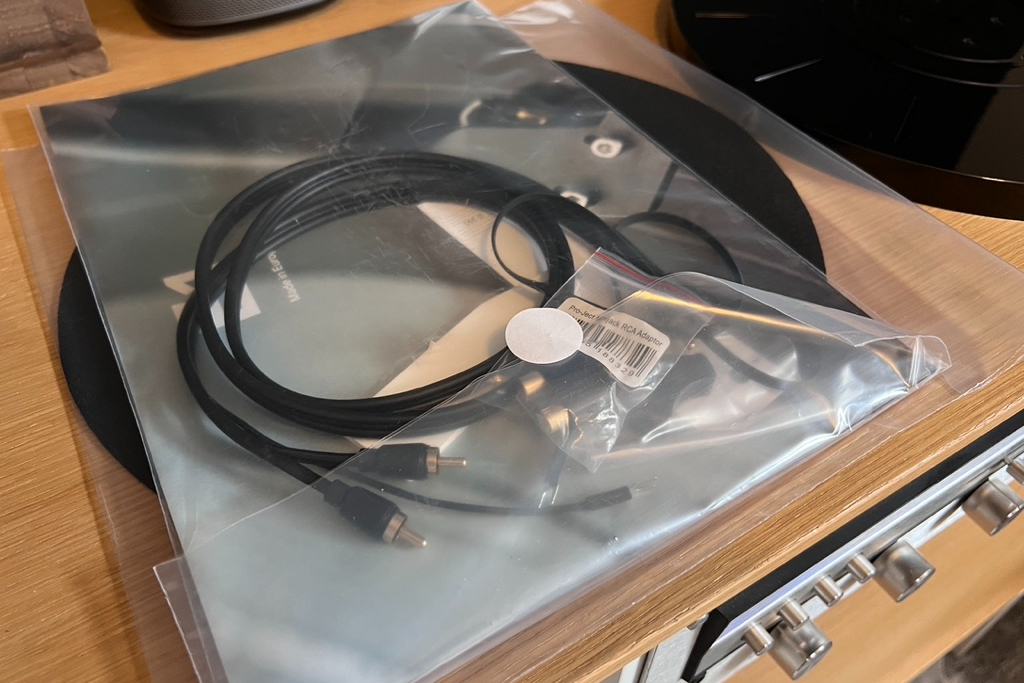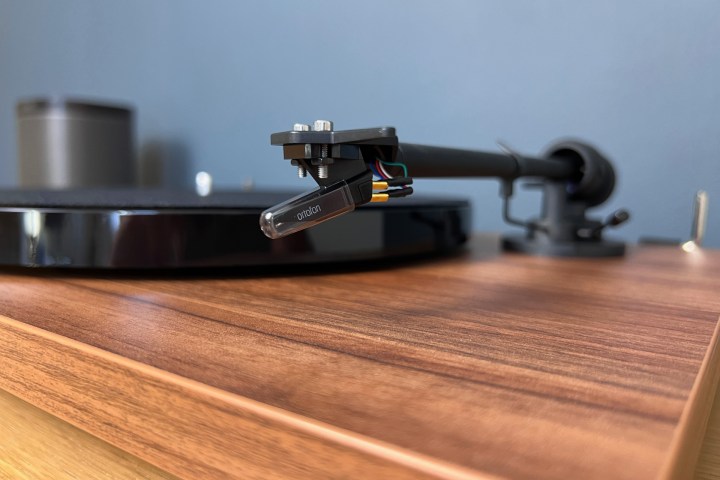“The Pro-Ject E1 Phono is an upgradable, entry-level turntable with big, clear sound that will grow on you.”
- Stylish, great-sounding turntable
- Built-in phono preamp
- Upgradable Ortofon cartridge
- Speed switch
- Reputable Pro-Ject name
- Bluetooth model available
- Sound needs some EQing
- So light it slides around
- Molded plastic platter, not solid acrylic
- No auto-stop function
When it comes to turntables, Pro-Ject Audio has been responsible for some of the biggest hits in the industry, such as its hugely popular Debut lineup that’s still killing it to this day. To be sure, the Austrian company makes some serious audiophile decks that cost as much as a decent used car, but where Pro-Ject excels is on the affordable end of the spectrum, making quality turntables accessible to anyone looking to start digging into vinyl — and if you’re here, that likely means you.
Case in point: The Pro-Ject E Series is the company’s latest budget line that it launched in May 2022. A range of three entry-level turntables — the $350 base mode E1, the $400 E1 Phono with built-in pre-amp, and the $500 E1 BT with all that, plus Bluetooth connectivity. The E Series combines good looks with decent components that deliver a surprisingly big sound. They’re also a cinch to set up, making them perfect for newbies. But here’s the problem: Pro-Ject isn’t the only reputable deck maker vying for a piece of the budding record-collector pie, as it has to contend with the likes of Rega, Audio Technica, Fluance, U-Turn, Sony, and others to earn your dollars. But like I said, this is where Pro-Ject excels, and to borrow from Pink Floyd, the E1 Series is yet another brick in its formidable entry-level turntable wall. It’s worth noting that all three E1 turntables are identical, with the obvious differences — one doesn’t have a phono pre-amp, one does, and one has it plus Bluetooth connectivity. For my review, I tested the midtier E1 Phono. Let’s check it out.
Out of the box
Given Pro-Ject’s experience with making things simple for the uninitiated, it’s no surprise that the E1 Phono review unit I received was perfectly packed, easy to unpack, and had pretty much every doodad in a single bag. As with most turntables that don’t come in a suitcase, there’s some assembly required, and in the E1’s box, you’ll find everything you need, including the individually packaged platter, RCA cables with included ground wire, a 3.5mm-to-RCA adapter (for connecting to an AUX input or set of powered speakers), rubber belt, AC power supply with international adapters, dust cover, and a little Allen wrench for adjusting its stiff hinges.
Also in the bag, Pro-Ject has thoughtfully included a force-gauge protractor and a paper cartridge alignment tool. Now, you shouldn’t need these at setup as all the E1 turntables come “plug and play” from the factory (I’ll get to that below). But on the off chance that you need to set or reset the tracking force (the manufacturer’s suggested downward weight at which the stylus contacts the record’s grooves) or anti-skate setting (a light, outward force that counters the tonearm’s tendency to move inwards), whether at setup or down the road if you ever change the cartridge, then these tools are easy to use and will come in handy.
Setup
If you’re going to call a turntable “entry-level” then it stands to reason that it should be super easy for beginners to get up and running. And the Pro-Ject E1 is. As mentioned above, the E1 line comes with its tonearm and cartridge configured by the experts at the factory, unlike higher-level decks that not only require precision cartridge installation but also assembly and balancing of the tonearm, which can be finicky for the uninitiated. There’s none of that with the E1. Aside from installing the rubber belt to the drive, placing the platter on the spindle post, sliding the dust cover in place, and connecting the RCA cables (all basic setup stuff), setting up the Pro-Ject E1 Phono (or any in the series) should take less than 10 minutes.
Overall, the Pro-Ject E1 is a gorgeous, well-built turntable in the Austrian company’s sub-$500 entry-level range.
Unless, like with my review unit, it doesn’t. For some reason, the counter weight and its rod was inserted into the tone-arm assembly backward (likely from the previous reviewer), and I had to balance it myself. That said, I found that the basic force gauge protractor (that comes with most Pro-Ject turntables) worked pretty well and it didn’t take long to get everything balanced.
Design and build

Overall, the Pro-Ject E1 is a gorgeous, well-built turntable in the Austrian company’s affordable sub-$500 entry-level range. Its minimal design comes in white, black, and wood grain finishes (like my review unit), and is on par with many of the belt-driven turntables on the market, drawing its DNA from Pro-Ject’s long line of world-class turntables, including its award-winning Debut Carbon, which is still going strong as an audiophile-level turntable today.
The Pro-Ject E1 is a belt-drive turntable, a system that is considered quieter because the motors are separated and not directly connected to the platter like direct-drive decks. The E1’s minimal design also features a premounted cartridge and a counterweighted gimbal-balanced tonearm, as well as a basic but elegant cue lever and tonearm cradle — which is all you need.
But the E1 is light. Perhaps too light at just 7.7 pounds. It’s so light, in fact, that when you lift the dust cover, the stiffness of the hinges makes the whole deck move — you have to hold it down. Luckily, the hinges are adjustable with an included Allen wrench to loosen things to your liking. Similarly, when turning the turntable on with its side-mounted speed switch to start a record, the felt bottoms of the three isolation feet don’t create enough traction, so the whole turntable begins to slide. Maybe some grippy rubber footings would be better.
The E1’s practically feather-like weight is on account of the turntable’s materials — an anti-resonant 3/4-inch thick plinth made of what Pro-Ject calls a “CNC-machined composite fiber,” molded ABS polymer (plastic) platter, and a lightweight aluminum tonearm. While you could find thicker, heavier plinths and solid acrylic or aluminum platters on other entry- or mid-level turntables (like the fantastic Fluance RT85N) for better anti-resonance, the vinyl-curious beginners or casual listeners that the E1 is perfect for won’t care or won’t notice, as the E1 sounds great (more on that later).
Features and operation
Each of the turntables in the Pro-Ject E1 line offers all the features any beginner will need, and probably a couple that will set them up for success should they upgrade down the line.
To preamp or not to preamp
The first thing to get out of the way are the options Pro-Ject offers in this E1 range. At the bottom end of the scale is the $350, bare-bones E1, with its distinction being its lack of a built-in phono preamp, which means you’ll have to purchase one or use a receiver with a phono input to amplify the weak signal that turntable cartridges themselves typically emit.
For an extra $50, you can bump up to the E1 Phono (the unit I tested), which has the preamp built-in. This model gives you more versatility: you can line directly to a set of powered speakers or to the AUX input of a receiver or amp, plus you can choose not to use the built-in preamp and connect it to your own (they go for between $100 and $300), which are often better quality and what I would recommend if you have the means.
My first impressions of the Pro-Ject E1 were not great … but after some fine-tuning on the receiver, this thing started to sing.
Lastly is the $500 E1 BT, which adds Bluetooth 5.0 connectivity to the preamp so you can connect wirelessly to speakers and headphones. I did not test this model, so I cannot speak to how it sounds, although one of the reasons people choose vinyl records is their high-quality analog sound. In my opinion, compressing that sound so that it can travel wirelessly via Bluetooth reduces the sound quality defeating this purpose, but hey, you do you. I will admit, though, that if the convenience of wireless connectivity to headphones or, say, a set of speakers in a different room is a priority feature for you, then a Bluetooth model might be a good solution — you’ll also get the wired feature, so win-win. There is no USB connection on any of the E1 decks, so you won’t be able to easily rip your vinyl to digital files, but I don’t know anyone who does this.
Speed selection

All three of the Pro-Ject E1 models have an easily-accessible speed switch on the left side of the plinth allowing the choice of 33 1/3 or 45 RPM speeds, as well as the off position. This is great because as with many more expensive turntables, you have to switch the speed by manually moving the rubber belt, which is a pain. The E1 Phono I tested had a dead-on accurate speed of 33 1/3 RPM.
No auto stop
One thing that I was hoping to see on the E1 line is the auto-stop feature that seems to elude many turntables across all price ranges. This little accouterment can make a difference if you’re the type of person who listens to records while doing other things, and you want to save some wear and tear on your stylus by having the record stop once it’s reached the end of the side. For this price point, however, I guess it’s a feature that most can live without.
Performance

My first impressions of the Project E1 Phono were … not great. With the EQ set to flat and running the turntable through my trusty Schiit Mani phono preamp and my vintage Marantz 2226, and everything sounded dull — the low end was almost nonexistent and the highs were lacking definition. I even tried it through the Marantz’s phono input, which improved the warmth, but little else.
But then the E1 surprised me. Maybe the Ortofon OM5e stylus needed a little breaking in (reading some reviews on it suggested that it starts coming into its own after roughly 30 hours), but after four or five records (including Pearl Jam’s Ten, Radiohead’s OK Computer, and the Beatles’ Magical Mystery Tour), some fine-tuning on the receiver where I goosed the highs and activated the Loudness button, and this thing started to sing.
After some coaxing, the Pro-Ject E1 pumped out a respectably dynamic sound that kept getting better the more records I spun.
While the Ortofon OM5e is a lower-end cartridge, it’s hard to go wrong with anything from the reputable Danish company (I use their 2M Red and Blue on my own decks and love them). Ortofon cartridges tend to be really forgiving of a wide range of tonearms and turntables, as well as with many types of music, so it doesn’t take a genius to see why Pro-Ject chose one for its entry-level E series (it uses Ortofons on all its turntables, actually).

Sound-wise, the Pro-Ject E1 Phono pumped out a respectably dynamic sound that kept getting better the more records I spun. Lows and mids were big and tight and not at all boomy (except when faced with the low end of Metallica’s For Whom the Bell Tolls). Even the built-in preamp started to shine once I had the equalization sorted.
Everything from Strawberry Fields Forever’s Mellotron flute intro to the whiny bendy guitar of The Smiths’ How Soon is Now sounded clear and defined, with everything properly situated in the soundstage, making for a higher, bigger sound than I was expecting. Note: I did not test the E1 running it directly through a set of powered speakers without independent EQ control, so I cannot speak to its sound without having the ability to adjust it.
At higher volumes, the E1 did a good job too, keeping things pretty much free of distortion. But I would steer clear of putting your speakers on the same surface as the turntable (this is a good rule of thumb in any case). When I did this with the lightweight E1 and pushed the volume, there was some skipping. One main job of a turntable is to isolate itself from vibration, with things like the plinth, tonearm, platter materials, weight, and isolation feet. A speaker’s job is the opposite — it’s to create vibration. While it won’t be an issue at normal volumes (and you can purchase all kinds of sound-isolating products), if you like your music loud and this is the only setup you can configure, you may have an issue.
Our take
The Pro-Ject E1, after a little EQ tweaking, sounds big, clean, and dynamic across a wide range of musical styles, and is a solid entry-level choice for the money. With its range of basic, preamp, and Bluetooth-enabled options suited to fit any beginner’s own setup configuration — whether you have yet to fork over the cash for a receiver or a have a pair of decent powered speakers — the E1 range offers choice, which is key if you’re just getting started. I would, however, recommend the E1 for those with setups that have independent EQ features, like a stereo receiver with bass, mid, and treble controls. Connecting to a system through Bluetooth might open these options as well.
How long will it last?
Pro-Ject has been making award-winning turntables for more than 30 years, and they’re built to last. So the short answer is that they should last quite a long time. Compared to some cheaper beginner decks that don’t let you upgrade any parts as you gain experience, Pro-Ject is known for helping you out as your vinyl addiction grows.
It’s a simple thing, but changing a stylus on a turntable is one of the best ways to improve the sound of even the most beginner level of turntables. The Ortofon OM5e has a range of stylus upgrades that can do just that, for years or until you start getting more serious. Pro-Ject is also good with replacement parts like platters, belts, and accessories.
Is there a better alternative?
That’s a tough one. As I mentioned, as more people start getting into records, the market for lower-end, entry-level turntables has heated up. There are certainly comparable products out there that would do you just as well as the Pro-Ject E1, such as the U-Turn Orbit Plus, a popular deck that comes with built-in preamp and the same Ortofon OM5e cartridge for the same $400 price, but with a thick acrylic platter.
However, it comes with its downsides, such as having to manually change speed by moving the belt (which can drive even seasoned record heads crazy) and the lack of a cue arm. That said, Pro-Ject’s own $450 T1 SB is an award-winning turntable that is almost identical to the E1, but with an acrylic platter and machined wood plinth, if those materials are on your mind.
Audio-Technica is another mainstay in the entry-level turntable game, with its hugely popular direct-drive AT-LP120 decks that start at around $330, but these are heavy and bulky and targeted more at DJs for their stability. They do, however, have a belt-drive sibling, the AT-LPW40W ($380), that has very similar features to the E1, with a preamp, aluminum platter, and comparable Audio-Technica cartridge, the widely used and upgradable AT-VM95. All are great choices, depending on your needs and budget, but the Pro-Ject name is synonymous with audiophile sound, and that’s something to consider.
Should you buy it?
Yes. For the price, features, and brand-name assurance, any one of the E1 series Pro-Ject turntables would be great for anyone getting started in the world of vinyl. The upgrade factor is key here, though, and with Pro-Ject aligning with Ortofon for its cartridges, you’re setting yourself up for long-term enjoyment if you continue on your vinyl journey.














